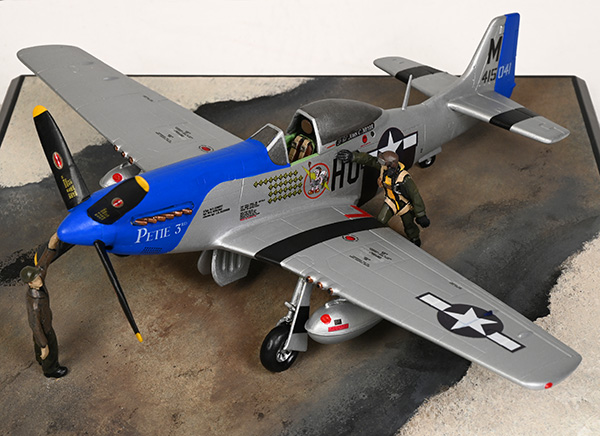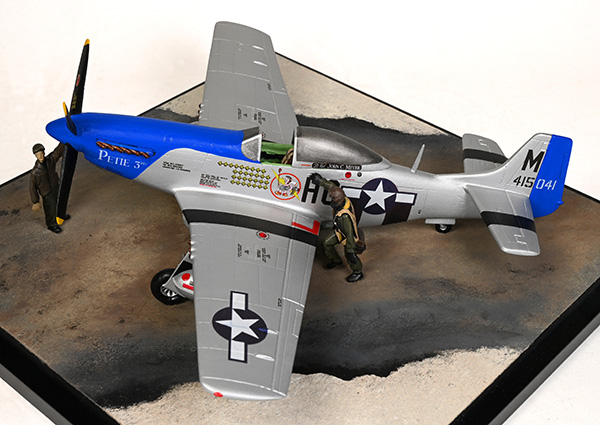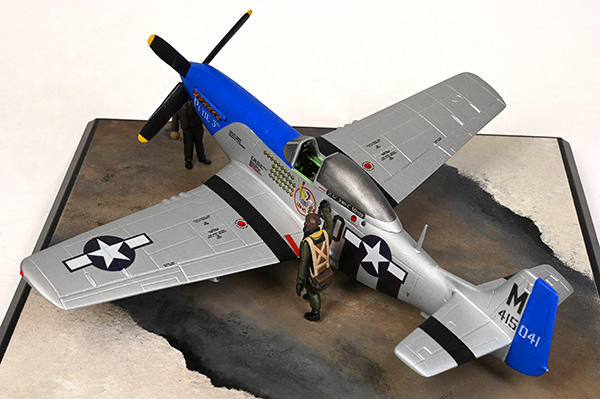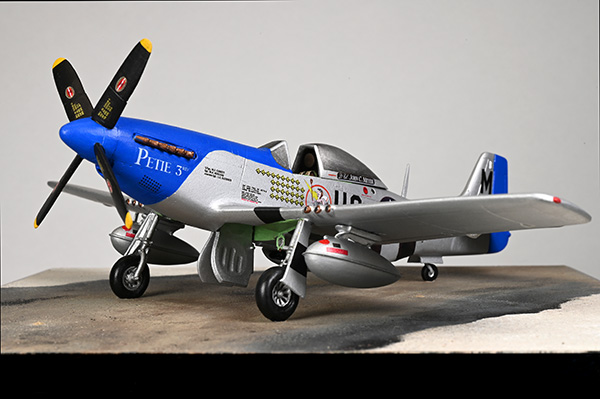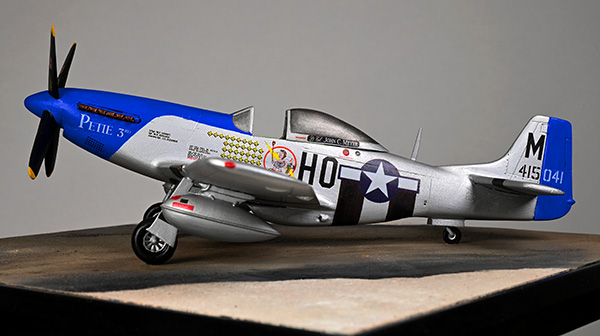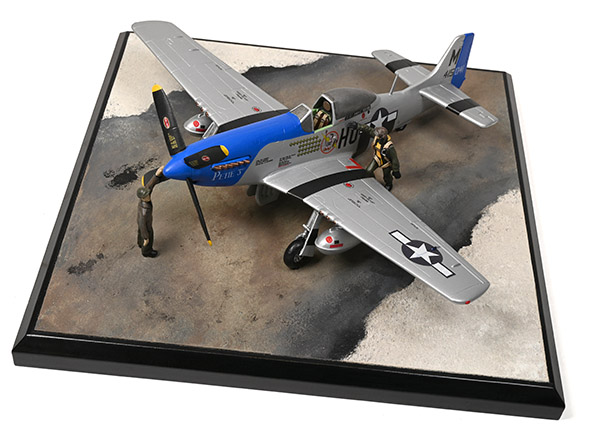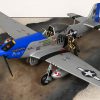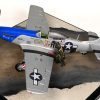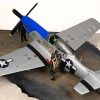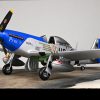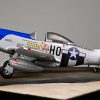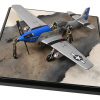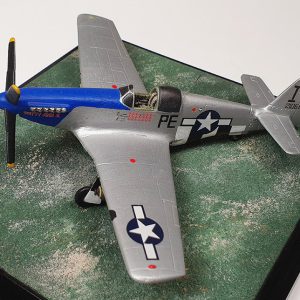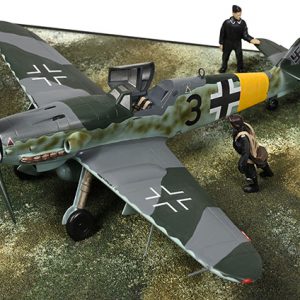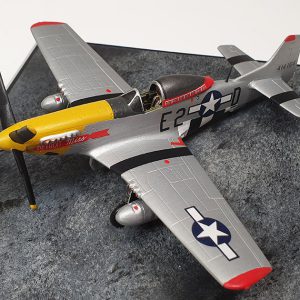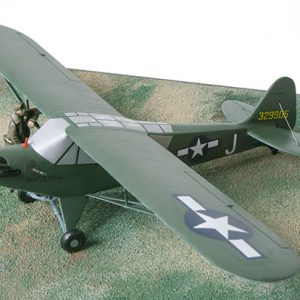North American P-51D
P-51D-15 44-15041 “Petie 3rd” HO-M, 352nd FG
flown by Lt Col John C Meyer,
Asch Airfield (Y-29), Belgium, January 1st 1945.
The Mustang was designed in 1940 by North American Aviation (NAA) in response to a requirement of the British Purchasing Commission. The Purchasing Commission approached North American Aviation to build Curtiss P-40 fighters under license for the Royal Air Force (RAF). Rather than build an old design from another company, North American Aviation proposed the design and production of a more modern fighter. The prototype NA-73X airframe was rolled out on 9 September 1940, 102 days after the contract was signed, and first flew on 26 October.
Early Mustangs used the Allison V-1710 engine which had limited high-altitude performance. The aircraft was first flown operationally by the Royal Air Force (RAF) as a tactical-reconnaissance aircraft and fighter-bomber (Mustang Mk I). Replacing the Allison with a Rolls-Royce Merlin resulted in the P-51B/C (Mustang Mk III) model and transformed the aircraft’s performance at altitudes above 15,000ft allowing it to compete with the Luftwaffe’s fighters. The definitive version, the P-51D with its distinctive ‘teardrop’ canopy, was powered by the Packard V-1650-7, a license-built version of the two-speed two-stage-supercharged Merlin 66, and was armed with six .50 calibre Browning machine guns with a total of 1,880 rounds. A new laminar flow wing of greater thickness allowed the Brownings to be mounted upright eliminating the ammunition feed issues of previous models.
The P-51D/P-51K started arriving in Europe in mid-1944 and quickly became the primary USAAF fighter in the theatre. It was produced in larger numbers than any other Mustang variant. Nevertheless, by the end of the war, roughly half of all operational Mustangs were still P-51B or P-51C models.
One of the most successful of all Mustang pilots was John C Meyer. He enlisted in the United States Army Air Corps in November 1939. In July 1940 he was commissioned a second lieutenant and awarded pilot wings.
Captain Meyer took the 487th Fighter Squadron, equipped with Republic P-47 Thunderbolt fighters, to its new base at RAF Bodney in East Anglia and into combat, scoring its first victory in November. By then he had been promoted to major and began leading the group in aerial victories. He continued to score against German fighters and remain a leading ace after the 352nd transitioned to the North American P-51 Mustang and adopted their famous “Blue Noses”. By November 1944 he was deputy commander of the 352nd Fighter Group and the fourth highest scoring American ace in Europe with 24 confirmed air-to-air victories and 13 destroyed on the ground.
In December 1944 Meyer, as a Lieutenant Colonel, deployed with the 352nd to a forward base in Belgium designated ‘Y-29’ when the field was attacked by fighters of Jagdgeschwader 11 in the massive aerial assault known as Operation Bodenplatte.
Operation Bodenplatte (Baseplate), launched on the 1st of January 1945, was an attempt by the Luftwaffe to cripple Allied air forces in the Low Countries during the Second World War. The goal of Bodenplatte was to gain air superiority during the stagnant stage of the Battle of the Bulge so that the German Army and Waffen-SS forces could resume their advance. The operation was planned for 16 December 1944, but was delayed repeatedly due to bad weather until New Year’s Day, the first day that happened to be suitable.
Secrecy for the operation was so tight that not all German ground and naval forces had been informed of the operation and some units suffered casualties from friendly fire. British signals intelligence (Ultra) recorded the movement and build-up of German air forces in the region, but did not realise that an operation was imminent.
The Asch Airfield (Designated: Y-29) had been constructed in November 1944 and was home to the 352nd and 366th Fighter Groups. It was one of 17 airfields targeted by the Luftwaffe. Jagdgeschwader 11 (JG 11) was tasked to destroy the airfield using a combination of Fw190s and Bf 109s totalling about 30 aircraft.
Asch was notable for a chance event. The 390th Squadron of the 366th Fighter Group had launched two fighter sweeps that morning, which played a crucial role in the failure of JG 11’s attack. The leader of the 487th squadron, 352nd Fighter Group, John Charles Meyer, anticipated German activity and had the 487th squadron’s 12 P-51s pre-flighted and ready to take off on a combat patrol when the attack began on the morning of January 1st 1945. This averted a major disaster as they took off under fire from the attacking Luftwaffe.
Several pilots made ‘Ace’ status that day. No P-51s were lost; two were damaged and one was damaged on the ground. The 336th Fighter Group lost one P-47. The 366th was credited with eight enemy aircraft, and AAA claimed seven more. Luftwaffe records indicate JG 11 lost 28 fighters. Four German pilots (two wounded) made it back to German-held territory, while four were captured and the remaining twenty were killed. German ace Günther Specht was among those German pilots killed. Total JG 11 losses were 28. The air battle over Asch had lasted 45 minutes and also came to be known as, ‘The Legend of Y-29’, and encapsulated the failure of Operation Bodenplatte as a whole.
Meyer led the take-off under fire and scored against a strafing Fw 190 before his landing gear retracted earning a Distinguished Service Cross that day. What follows is his citation.
‘The President of the United States of America, authorized by Act of Congress July 9, 1918, takes pleasure in presenting a Second Bronze Oak Leaf Cluster in lieu of a Third Award of the Distinguished Service Cross to Lieutenant Colonel (Air Corps) John Charles Meyer, United States Army Air Forces, for extraordinary heroism in connection with military operations against an armed enemy while serving as Pilot of a P-51 Fighter Airplane and as Deputy Commander, 352d Fighter Group, Eighth Air Force, in aerial combat against enemy forces on 1 January 1945. On this date, to save the airfield and ground personnel from extensive damage by a surprise enemy strafing attack, Colonel Meyer unhesitatingly led his squadron off the field in the face of an attacking force of approximately fifty hostile fighters, and engaged the enemy as they initiated their first strafing run. Despite the enemy’s great tactical advantage in numbers and position, and although his own aircraft was burdened with loaded wing tanks and its maneuverability greatly reduced, Colonel Meyer viciously engaged the enemy formation, personally destroying two of their aircraft. His valiant action in the face of extreme danger unquestionably saved the airfield from great damage. The extraordinary heroism and complete disregard for his personal safety displayed by Colonel Meyer on this occasion reflect highest credit upon himself and the Armed Forces of the United States.’
Operation Bodenplate achieved some surprise and tactical success, but was ultimately a failure. A great many Allied aircraft were destroyed on the ground but replaced within a week. Allied aircrew casualties were quite small, since the majority of Allied losses were grounded aircraft. The Germans, however, lost many pilots who could not be readily replaced. Bodenplatte was the final large-scale strategic offensive operation mounted by the Luftwaffe during the war.
For John Meyer a vehicle accident left him with a severe leg injury thereby ending his combat flying with the 352nd after flying 200 combat missions with 462 combat flying hours and scoring 24 aerial victories with another 13 credited to ground strafing.
During World War II, Mustang pilots claimed to have destroyed a total of 4,950 enemy aircraft.


